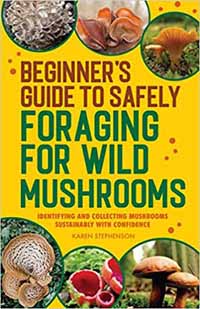

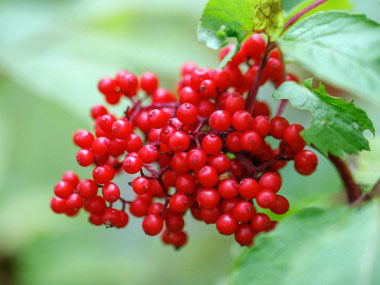
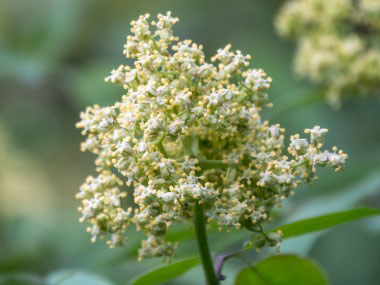
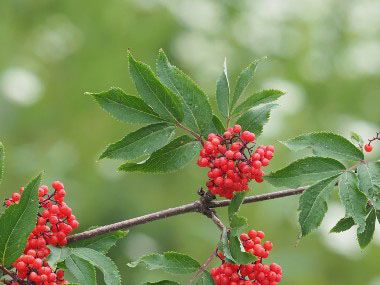
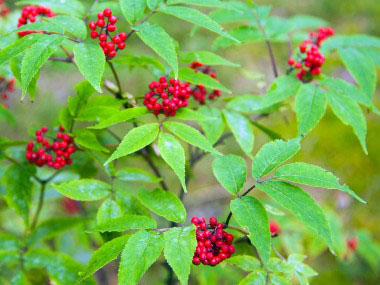
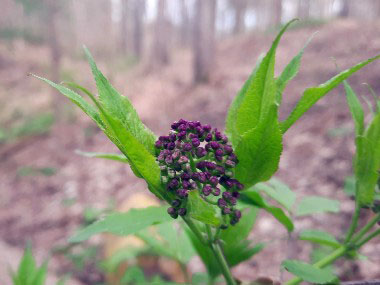
To support our efforts please browse our store (books with medicinal info, etc.).
Red Elderberry is a ubiquitous shrub that is one of the first shrubs to bloom in spring. The early blossoms and bright red fruits make it relatively easy to identify. This shrub grows best in forest openings. Its seeds can remain dormant for many years until a gap opens and stimulates germination. It can also stump-sprout from the root crown following a fire or being cut. Birds and mammals (such as bears) enjoy the fruit. The related Common Elderberry (Sambucus canadensis) flowers (and fruits) later in the season.
Trunk/Bark
Older bark is brownish-gray with shallow fissures. It becomes rough with thin, plate-like scales. Stems can reach to 11cm (4 1/2") in diameter, and are erect to arching.
Branches/Twigs
Twigs are hairless, green with a creamy white pith and scattered lenticels in the first year. The bark turns brownish gray the second year and the pith becomes orange-brown.
Height
This shrub grows up to 6 metres (20') in height.
Leaves/Needles
Leaves grow opposite, compound in groups of 5 or 7. Leaflets are usually lance to elliptic, measuring 5 to 12 cm (2 to 5") long, and 2.5 to 3cm (1 to 2" wide. Leaves taper to a pointed tip, margins are serrated, and short stalked to stalkless. The leaf upper surface is hairless to sparsely hairy along the midvein; the lower is paler in color and variously hairy, especially along major veins.
Flowers
This shrub produces inflorescences of large pyramidal clusters at the ends of the branches. Individual flowers are about 1/2 cm (1/4") across, white to creamy colored, with 5 petals. Each flower has 5 creamy-tipped stamens which surround a pale ovary with a short, 3 to 5 parted stigma at the top. Flower stalks are light green and sparsely to densely short-hairy.
Fruit
Fruit is a bright red berry that measures 1/2 cm (1/4") or less in diameter. Each berry contains 3 to 5 seeds.
Habitat
This shrub prefers moist to wet soils along streams, in woodlands and open areas from valleys to around an elevation of 3,000 metres. It can be found in most areas forested areas across the U.S. (including Alaska) and Canada.
Edible Parts
While the seeds of the red elderberry are poisonous, if they are removed, the berries may be eaten raw or cooked. They can be enjoyed in foods such as pies, jellies, or even to make wine. Flowers can be used raw or cooked. And according to PFAF, the root can be made into a tea.
Other Name
Red Berried Elder.
Recipes
Winter Survival Food Handbook

PDF Plant Magazines
Types of Wild Food
Geographic Zones Seasons
Disclaimer
EdibleWildFood.com is informational in nature. While we strive to be 100% accurate, it is solely up to the reader to ensure proper plant identification. Some wild plants are poisonous or can have serious adverse health effects.
We are not health professionals, medical doctors, nor are we nutritionists. It is up to the reader to verify nutritional information and health benefits with qualified professionals for all edible plants listed in this web site. Please click here for more information.
Why Edible Wild Food?
- Food costs are rising
- Free, wild food is readily abundant
- Wild food adds nutrition to your diet
- Wild food can help treat various medical conditions





